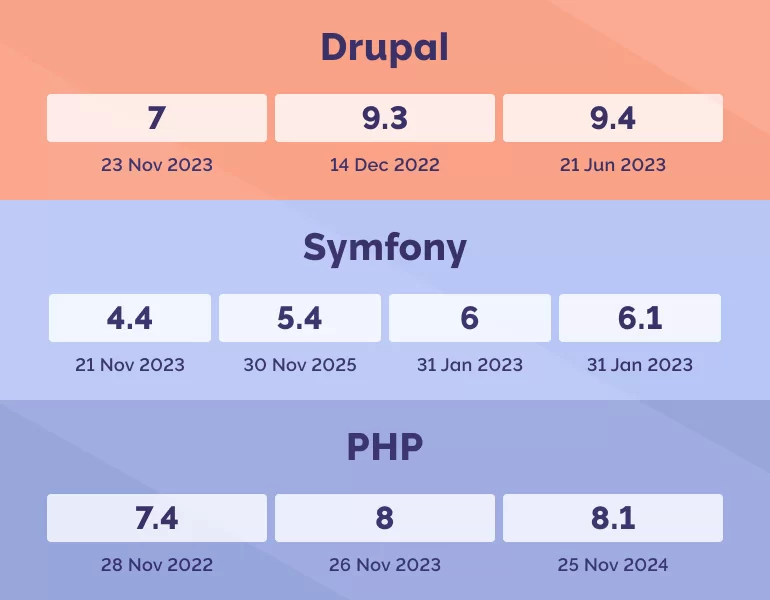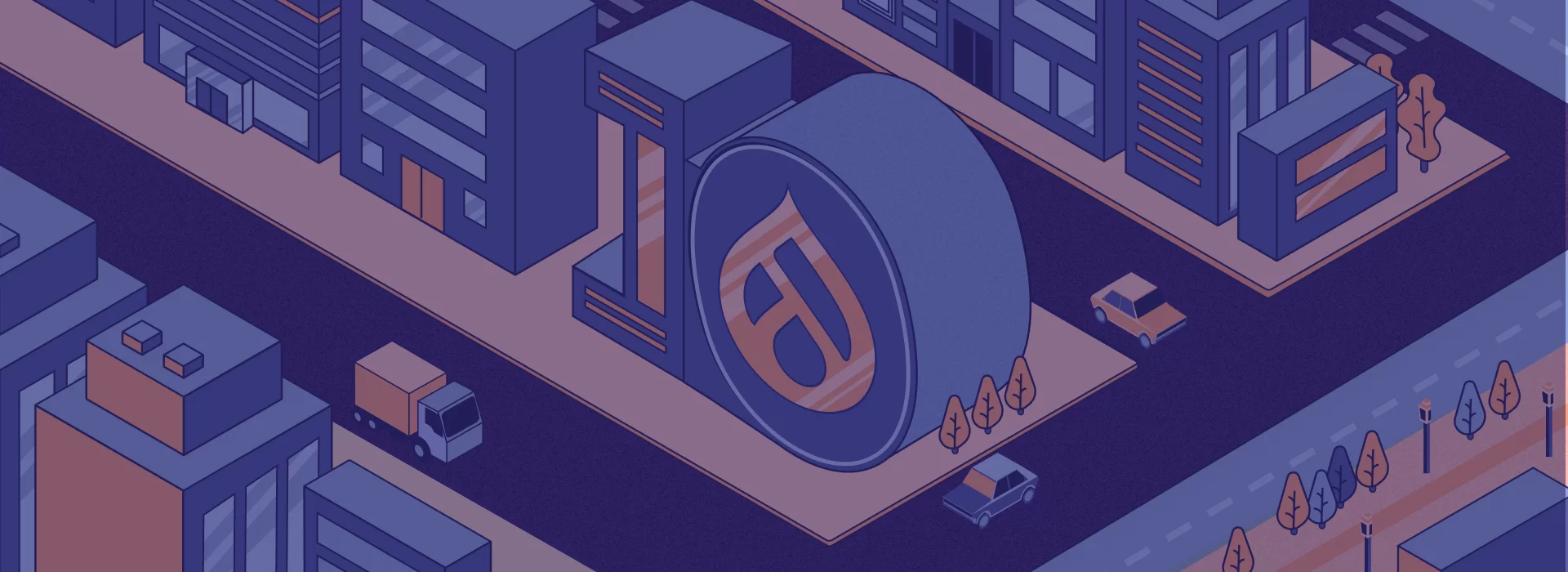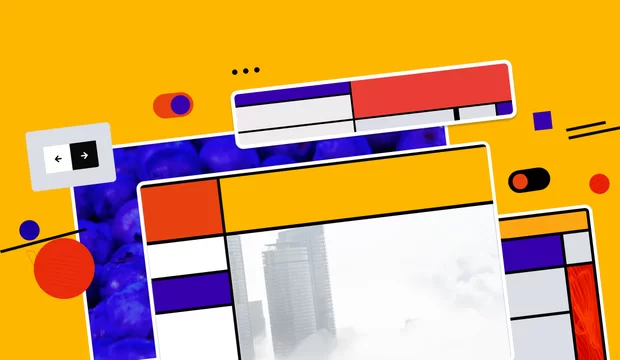What Drupal version is your site running on? As the usage statistics of Drupal core says, there are still those using Drupal 5, Drupal 6, and Drupal 8. In this case, you miss out on the new features of the admin panel and community-supported modules, themes, and profiles, while your clients lose up-to-date user experience and cannot have confidence in your site’s security. These versions are not supported anymore. Further down the road, there is only migration to Drupal 9 or website development on Drupal 10 from scratch. Read on to see how reasonable this step is.
Drupal 9, we’ll never forget you
Only two years ago website developers and administrators cheered loudly for the release of Drupal 9. Here are just some of the reasons for such a cordial welcome:
- Reverse compatibility makes it possible for the developers to use Drupal 9 with the same modules, configurations, and data they used in Drupal 8;
- All code marked in Drupal 8 as deprecated was removed from Drupal 9;
- The core of Drupal 9 includes the components of PHP framework Symfony 4 and template processor Twig 2 — more recent software versions as compared with those used in Drupal 8;
- Migration from Drupal 8.9 to Drupal 9 takes much less time than migration from Drupal 7 to Drupal 8;
- The experimental site management theme Claro is built into the core;
- Some more of the most popular modules, including those used for administering and content management, are integrated into the Core and are updated with the core;
- The Panelizer module has been replaced with Layout Builder.
- The new version makes Drupal closer to the Headless CMS architecture.
The end of Drupal versions support is tied to at least two technologies: PHP and Symfony. Below you can see the current versions of PHP, Symfony, and Drupal, as well as the their End of Life dates, ie when their official support ends.

Drupal, PHP, and Symfony End of Life dates
What is the main point for Drupal 7 and Drupal 9 site owners? Bug fixes for Symfony 4.4 will be no more available at the end of November 2022, and security support — at the end of November 2023. Consequently, from this time on, it will be unsafe to use your Drupal 7 website. The projects based on a newer CMS have an even shorter life span: Drupal 9.3 and Drupal 9.4 sites will turn into a target for exploits starting from December 2022 and June 2023, correspondingly. However, the update from the old major Drupal version to the new one won’t be more complex than a security update.
What surprises Drupal 10 will have for us
It’s known already that Drupal 10 will operate on PHP 8.1 or higher and Symfony 6.2 which is due to be released in November 2022. And now that you know what you are going to do in the next year and a half until the previous technologies become obsolete, let’s discuss what to expect in Drupal 10.
Remote obsolete code
Developers of the core, for their part, do their best to make migration from Drupal 9 to Drupal 10 as seamless as possible: they mark the obsolete code and remove old features while preserving the reverse compatibility that will run out as soon as the old code is deleted. However, the issues with migration to the new API will affect only the site developers who were not paying enough attention to the code while supporting Drupal 9 websites. This approach has turned out to be great for migration from Drupal 8 to Drupal 9.
CKEditor 5
WYSIWYG editor CKEditor appeared for the first time in Drupal 8. At the time it was the fourth version of this editor but its secure operation will end in 2023. Integration of CKEditor 5 was one of the most difficult tasks for the core developers, which was the reason to postpone the release till December. On the other hand, admins will get a tool looking similar to more familiar Microsoft Word and Google Docs. A contextual balloon popping up when you click on selected text and tip or when adding an image now allows editing the content in real-time mode. It will be easier to work with images as you’ll be able to add them to the pages simply by dragging them.
Automated updates of the core and modules
Before, Drupal could not be updated out of the box — developers wrote special scripts to check for newly released updates and generally carried out this procedure based on the updates policy adopted by the project team. In Drupal 10, updates will work on the principle “set up once and forget for good”. This is a great advantage for those who are not experienced in programming and manage small projects with a small number of dependencies.
JavaScript components
Starting from Drupal 5, the CMS core has included some elements of jQuery — a special JavaScript library that allows solving tasks in one line instead of spending several hundreds of JS code lines. Specifically Drupal uses jQuery UI — a set of plug-ins and widgets to create interactive interface elements. Now you can forget about this as the core developers decided that it was high time to get rid of this dependence on jQuery UI with its irregular security updates and releases and replace it with Vanilla JS. However, time will show how good this replacement is.
Decoupled menus
The decoupled menus are implemented to create the most flexible conditions for front-end developers in terms of using the menu configurations managed in Drupal.
Olivero default front-end theme
Olivero, which appeared in Drupal 9.1 as an experimental theme, will now become the default theme for the front end. The previous theme, Bartik, had been used since 2011 and no longer tuned in to the spirit of the times. The Olivero impresses with the state-of-the-art design seen in typography, animation, and color palette, support of new Drupal features (second-level navigation, embedded media, layout builder, and more), and compliance with the Web Content Accessibility Guidelines, level AA.
Claro administration theme
This is another step toward the users, this time site developers, administrators, and content managers. The Claro theme will replace the default theme Seven for the admin panel. It was introduced in Drupal 8.8 as an experiment but gained the reputation as a stable theme by the tenth version and is now used by default.
Starterkit theme generator
Drupal theme developers will have a stable Starterkit theme generator. Before, each new theme had to be based on the Classy theme and, consequently, inherit its CSS classes and markup. The Classy theme has not been updated since Drupal 8 due to reverse compatibility issues.
The Starterkit will become the tool that allows developers to save time in the future. They will be able to use it to copy default themes in a new folder and inherit the CSS and HTML just from them. This will allow changing the base theme safely without being afraid to affect the default themes.
Only the best is down the road
Those who selected a CMS some time ago and opted for Drupal must realize for themselves how lucky they are. Many features and improvements in Drupal 10 that have been described in this post are on the list of strategic initiatives which are developed, among other participants, by Dries Buytaert, the Drupal’s founder. Their selection is based on usability studies, views of the idea and its development, the striving for fair competition in the CMS market, and discussion among the community members. While such systemic work makes Drupal more convenient both for developers and administrators without programming skills, it also distinguishes Drupal from other CMSs for websites.
We are thrilled with its development course and just to think, Drupal 11 was casually mentioned during the DrupalCon 2022. As soon as we know any specifics, we’ll share them with you.




